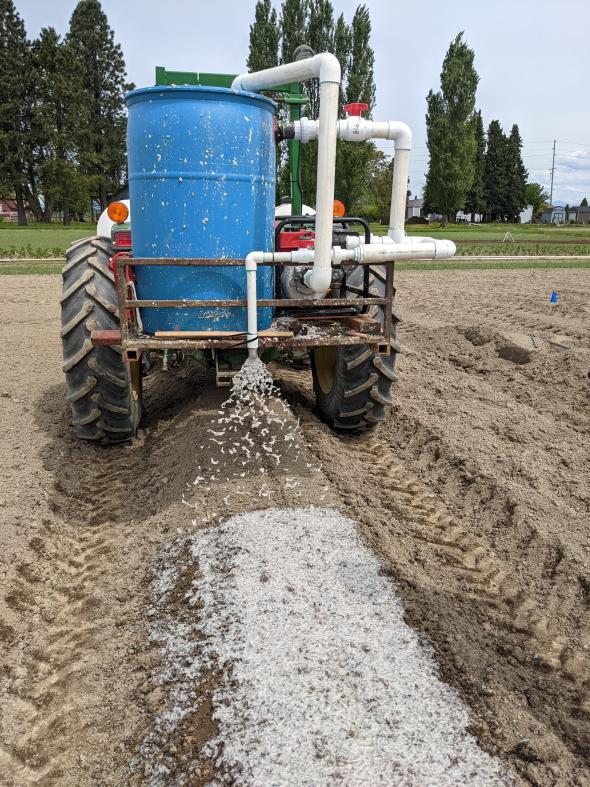Study Shows Hydromulch Is Promising for Berry Crops

A new hydromulch slurry containing water, cellulose, and a tackifier that helps adhere cellulose fibers together is being applied to strawberry raised beds.
Photo by Lisa DeVetter
Have you ever dealt with the pain of using plastic mulch made from polyethylene (i.e., PE mulch)? Sure, it lays nice, works great for weed suppression, and optimizes soil conditions to promote plant growth. However, these benefits come at a cost. PE mulch is difficult and costly to remove and dispose of at the end of the season. Moreover, removal is often incomplete, leaving behind non-biodegradable plastic fragments in the soil that can jeopardize soil health and pollute the surrounding environment.
Although soil-biodegradable plastic mulches and improved recycling technologies are promising solutions on the horizon for addressing the challenges of PE mulch, the organic sector is still short on solutions that fit within the organic framework. Even though PE mulch can be used in organic production, some growers avoid using this material given the sustainability issues associated with generating vast amounts of PE mulch waste each year, which usually ends up in landfills.
Furthermore, currently available soil-biodegradable plastic mulches are not allowed in certified organic production due to their material composition and uncertainties about their effects on soil health.
To address these challenges faced by the organic industry, North Dakota State University teamed up with Montana State University, Oregon State University, and Washington State University on a federally funded project that seeks to develop sprayable mulch made from ingredients allow-able for organic production. Note however, organic growers should always check with their certifier before applying any product, including the aforementioned hydromulch.
This new hydromulch consists of a slurry containing water, cellulose, and a tackifier that helps adhere cellulose fibers together.
In addition, hydromulch is applied using equipment similar to that used for hydroseeding in the landscape and restoration industry for erosion control.

Strawberries grown with hydromulches show favorable fruit production.
Photo by Lisa DeVetter
MULTI-STATE STUDY
Last year, North Dakota State University and Washington State University completed a multi-state trial that evaluated various hydromulch formulations in day-neutral strawberry. Formulations included recycled newsprint paper as a cellulosic feedstock, plus tackifiers of either psyllium or guar gum at various percentages. Results were promising. The hydromulch was found to be comparable to PE mulch at weed suppression. The exception to this was for pigweed and thistle, which hydromulch did not suppress.
Despite some gaps in weed suppression, hydromulch outperformed the PE mulch treatment in terms of fruit yield.
Fruit quality was comparable across the treatments, indicating hydromulch maintained fruit quality.
The mechanism leading to elevated yields in the hydromulch treatment is uncertain at this point but may be attributed to improved canopy and/or soil conditions experienced by the strawberry roots.
Both soil temperature and moisture levels were monitored in the trial. Soil moisture was relatively unchanged compared to
PE mulch; however, soil temperature was higher under PE mulch than under hydromulch. Although growers in the study areas are generally interested in elevating soil temperature under mulches, it is possible soil temperature conditions under hydromulch were more favorable for strawberry and led to increased fruit production.
Research on hydromulches and other new mulch technologies that meet conventional and organic growers’ needs is ongoing. One of the most exciting things about hydromulch is its potential to be multifunctional, while other mulches are not.
For example, hydromulches could be blended with fertilizers, or even pesticides, for additional benefits. Mustard seed meal and corn gluten are two options that could contribute to weed suppression in a multi-functional hydromulch. Colorants could also be added to hydromulches to alter light reflectance into plant canopies and soil temperature, which, in turn, could impact crop performance.
To date, the research on hydromulches is promising and will hopefully provide organic and conventional growers alike with a new tool to manage weeds and promote crop growth. You can learn more about hydromulches at our website: EOrganic.Info/Hydromulch.
Acknowledgement: This project is funded by the Organic Research and Extension Initiative grant, part of the USDA National Institute of Food and Agriculture. Grant number 2021-51300-34909.
Author’s Note: Special thanks to Ben Weiss, graduate student at Washington State University, for his work on this project and in co-authoring this article.










